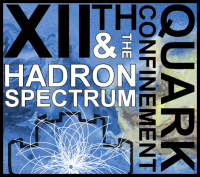Speaker
Description
The renormalization group procedure for effective particles (RGPEP) has been
developed during the last years as a non-perturbative tool for constructing
bound-states in quantum field theories [1]. It stems from the similarity
renormalization group procedure (SRG) [2] and introduces the concept of effective
particles, which differ from the point-like canonical, bare ones by
having a finite size $s$. The effective particles in the Fock space build
the hadronic eigenstates of a family of effective Hamiltonians H_s depending
on the size s as the RGPEP scale parameter. We apply the RGPEP
to QCD using an expansion in powers of the coupling constant up to third order.
The Hamiltonian running coupling, $g_s$, is extracted from the interaction terms
in $H_{s}^{QCD}$ [3]. We thus demonstrate that the RGPEP passes the test of describing
asymptotic freedom, which is a precondition for any approach aiming at using
QCD for explaining hadrons in the Minkowski space-time, especially for tackling
nonperturbative issues, such as the ones that emerge when one allows effective
gluons to have masses [2]. Applications of this method beyond the leading order are under way and it is hoped that the interaction terms relevant to understanding of confinement will be gradually determined.
[1] S. D. Glazek, Acta Phys. Polon. B42 (2011) 1933; Acta Phys. Polon. B43 (2012) 1843.
[2] K. G. Wilson, T. S. Walhout, A. Harindranath, W.-M. Zhang, R. J. Perry, and S. D. Glazek, Phys. Rev. D49 (1994) 6720-6766
[3] M. Gomez-Rocha and S. D. Glazek, Phys. Rev. D92 (2015) 065005.
